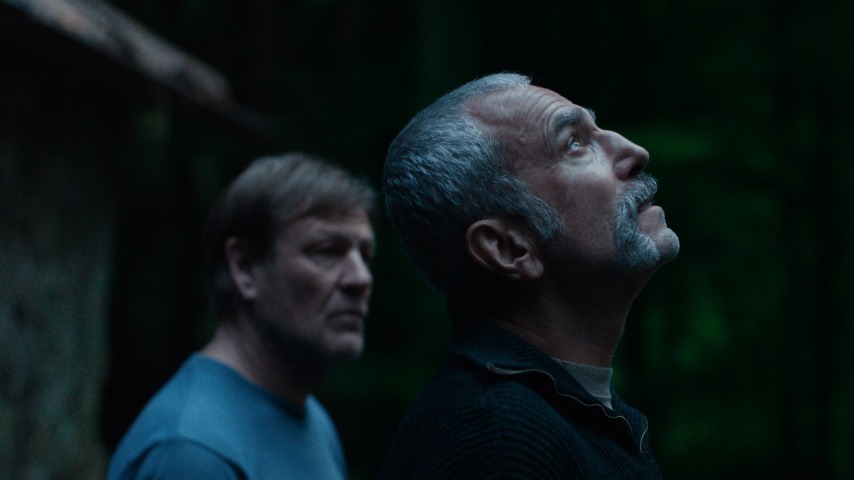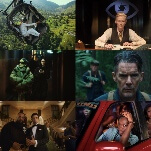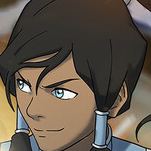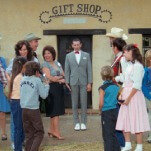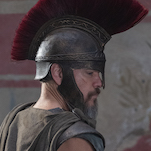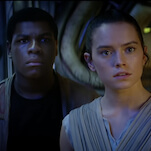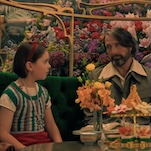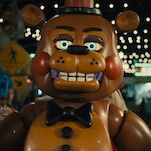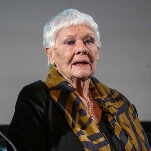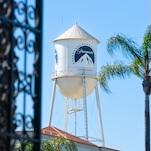A famous father and his son making a film about a son with an absent father is a bit on the nose, no? Not if you’re the Day-Lewises. Regardless of what truth peeks through the fiction of Anemone, debut writer-director Ronan Day-Lewis and co-writer/star Daniel Day-Lewis give pop culture a heaping mound of mythos to sort through by playing into the lore of the living legend, who came out of retirement solely to make a film with his kid.
It’s been eight years since Daniel Day-Lewis was on the big screen and 20 years since his character, Ray Stoker, has seen his family. As many imagine Day-Lewis does in real life, Ray Stoker lives off the land in a single-room cabin alone in the woods, not speaking to anyone or encountering anyone to speak to. He’s a brooding, mysterious creature. He’s lived simply and undisturbed in the thick of the forest ever since he abandoned his pregnant wife Nessa (Samantha Morton) on a dime, for unknown reasons, leaving his brother Jem (Sean Bean) to care for her and their son Brian (Samuel Bottomley).
Now in his late teens, Brian expresses the sizzling anger embedded in his abandonment through brawls that leave his knuckles bruised and bleeding. As a last resort, Nessa and Jem decide to contact Ray, who is, of course, unreachable through any device. So, Jem sets out into the wilderness. A deeply religious man—the spiritual antithesis to his blaspheming brother—Jem believes he might be able to convince Ray to return if it means the livelihood of Ray’s only son, the son he didn’t stick around to meet.
This all seems undeniably personal. A famous (and famously ascetic) father and son, both of whom have two brothers, making a film about fathers, sons, and brothers. It’s as if they sat down and asked themselves: How do people see Daniel Day-Lewis? How can we depict the man they think he is in a dramatized way?
On top of characterizing Ray as a man no one has seen in a long time, who’s considering coming out of retirement for his son, the duo wrote lines like, “the invisible man: Ray Stoker,” and “family reunion” that speak directly to his public persona and the father-son collaboration, along with questions like, “How long has it been brother…since you went limping off into the woods?” and “Why did he leave us?” that might as well be coming from the mouths of his admirers. The duo even wrote Ray croaking “I’m beyond your reach” to an outsider. Unsurprisingly, Day-Lewis delivers every line with masterful, lived-in magnetism.
With a plot that remains obscured for a large portion of the runtime, and several significant plot details that stay in the shadows even longer, Anemone is full of festering secrets. They slowly rise to the surface through the sunken-wet soil the brothers trudge through on hikes in between liquored-up conversations, the only kind of conversation they can have, when they’re not swimming in a new body of water. Their several scenes in the water seem to exist out of time. They splash and play like young brothers, as if they’d never spent time apart. In all other scenarios, the lack of liquor and swimming only begets grim silence and near-tactile resentment.
Taking a cue from Midsommar—with whom Anemone shares the terrific composer Bobby Krlic, whose haunting scores fill both films with a dreadful, death-march determinism—Ronan Day-Lewis’ film opens on a handmade mural and moves quickly into a darkened forest. But where Aster’s mural captures the film’s entire plot through one super-wide shot of a painting on Nordic wood, Day-Lewis’ mural scrawls across the film’s undepicted background story through extreme close-ups of Technicolor crayon on construction paper. There’s something to be said about a child’s imagination of their father’s war-torn past—the unwarranted innocence, hopeful color, and strange simplicity depicted in our species’ greatest depravity. But it doesn’t have beauty or allure the way the rest of the imagery, and the story, does. It feels like a placeholder for a grittier Guernica-toned mural that was never made.
Yet, there’s a painterly impressionism to Ronan Day-Lewis’ vision that cinematographer Ben Fordesman captures with deep-colored acuity. A sequence in which Ray fearfully watches a gargantuan silvery fish, cut through the gut in fleshy red slashes, float in slow-motion down a granite-dark river is so expertly crafted and woven in, one would think it was made by a veteran hand.
While it wades in its mysteries and mythologies a bit too long, Anemone ends up being a poignant, promising project about the stains of war on the soul—in this case, the Irish Civil War—and the tendency for one to self-destruct in the aftermath of ruthless service, regardless of where one’s sense of duty or regret lies. It’s a cross-generational warning about lost spirits and the waywardness within passed on in families: a brother beyond another’s reach, a father beyond a son’s reach, and a son beyond his mother’s reach, as long as his father remains absent.
Director: Ronan Day-Lewis
Writer: Ronan Day-Lewis, Daniel Day-Lewis
Starring: Daniel Day-Lewis, Sean Bean, Samantha Morton, Samuel Bottomley
Release Date: October 3, 2025
